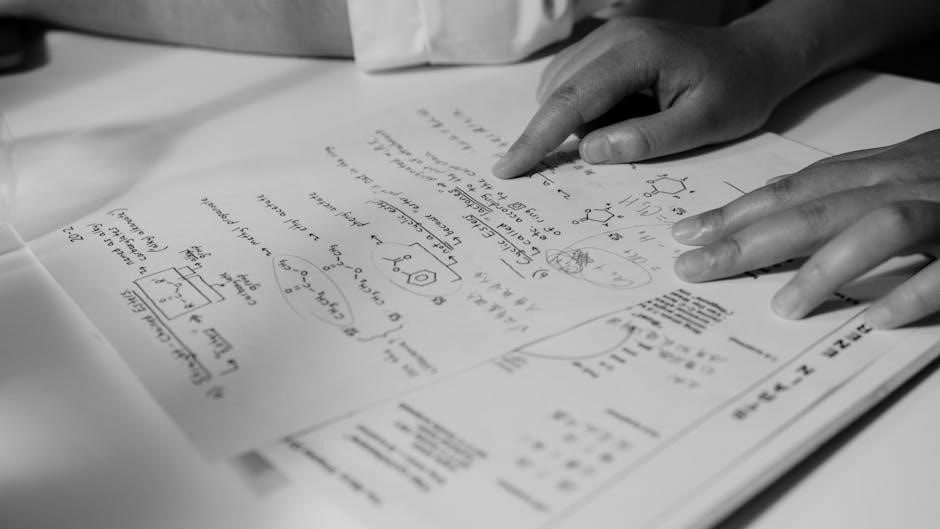To solve logarithmic equations‚ start by understanding the properties of logarithms and their applications‚ using online resources such as solving logarithmic equations worksheet with answers pdf for practice.
Definition and Restrictions of Logarithmic Expressions
Logarithmic expressions are defined as the inverse operation of exponentiation‚ where loga(x) = y is equivalent to a^y = x‚ with restrictions on the domain of x‚ such as x must be positive for real-valued logarithms. This definition is crucial in solving logarithmic equations‚ as it helps to identify the possible values of x. The restrictions on logarithmic expressions are essential to consider‚ as they determine the validity of the solutions. For instance‚ the expression log2(x) is only defined for x > 0‚ and log0(x) is undefined. Understanding these restrictions is vital in solving logarithmic equations‚ and online resources such as solving logarithmic equations worksheet with answers pdf can provide practice exercises to reinforce this understanding. By applying these definitions and restrictions‚ individuals can develop a strong foundation in solving logarithmic equations and improve their problem-solving skills. The key to success lies in careful consideration of the domain and range of logarithmic functions.

Steps for Solving Logarithmic Equations
Follow specific steps to solve logarithmic equations‚ using online resources like worksheets with answers for practice and review of mathematical concepts and procedures quickly.
Step 1: Determine the Type of Equation
To solve logarithmic equations‚ the first step is to determine the type of equation you are dealing with‚ which can be logarithmic or a combination of logarithmic and algebraic expressions.
This step is crucial as it helps in identifying the appropriate method to solve the equation‚ using online resources such as solving logarithmic equations worksheet with answers pdf for practice and review.
The type of equation will guide you on whether to use properties of logarithms‚ such as the product rule or the quotient rule‚ or to use algebraic manipulations to isolate the variable.
Understanding the type of equation is essential in developing a strategy to solve it‚ and online resources can provide guidance and examples to help with this step.
By determining the type of equation‚ you can choose the correct approach to solve it‚ and online worksheets can provide practice exercises to reinforce your understanding.
The key is to carefully analyze the equation and identify the appropriate method to solve it‚ using online resources as a reference.
Solving Logarithmic Equations Containing Terms without Logarithms
Use properties of logarithms and algebraic manipulations to solve equations with terms without logarithms‚ found in worksheets like solving logarithmic equations worksheet with answers pdf online resources.
Step 2: Apply the Rules of Logarithms
To solve logarithmic equations‚ it is essential to apply the rules of logarithms‚ which include the product rule‚ quotient rule‚ and power rule. These rules can be used to simplify logarithmic expressions and solve equations. For example‚ the product rule states that log(ab) = log(a) + log(b)‚ while the quotient rule states that log(a/b) = log(a) ⸺ log(b). The power rule states that log(a^b) = blog(a). By applying these rules‚ you can simplify complex logarithmic expressions and solve equations. Additionally‚ online resources such as solving logarithmic equations worksheet with answers pdf can provide practice problems and examples to help you master these rules and become proficient in solving logarithmic equations. With practice and patience‚ you can develop a strong understanding of logarithmic equations and improve your problem-solving skills.

Practice Problems and Worksheets
Online worksheets like solving logarithmic equations worksheet with answers pdf provide valuable practice problems and exercises.
Worksheet 1.5: Solving Logarithmic Equations
Worksheet 1.5 provides a comprehensive set of exercises for solving logarithmic equations‚ including problems with logarithms on both sides of the equation. The worksheet is designed to help students practice and reinforce their understanding of logarithmic equations‚ and to develop their problem-solving skills. By working through the exercises‚ students can gain confidence and fluency in solving logarithmic equations‚ and prepare themselves for more advanced math topics. The worksheet includes a variety of problem types‚ such as equations with logarithms on one or both sides‚ and equations with multiple logarithms. Students can use online resources‚ such as solving logarithmic equations worksheet with answers pdf‚ to check their work and get feedback on their progress. The worksheet is a valuable tool for students who want to improve their math skills and prepare for exams or assessments. Students can use it to identify areas where they need more practice or review.

Examples and Activities
Examples and activities include solving logarithmic equations using worksheets and online resources like pdf files for practice and review purposes only always.
Example 2: State the Restrictions on x
To state the restrictions on x‚ we need to consider the domain of the logarithmic function‚ which is all real and positive numbers.
This means that the argument of the logarithm‚ which is the expression inside the parentheses‚ must be greater than zero.
For example‚ if we have the equation log2(x)‚ then x must be greater than zero‚ since the logarithm of a non-positive number is undefined.
We can use online resources‚ such as solving logarithmic equations worksheet with answers pdf‚ to practice and review the restrictions on x.
These resources provide examples and exercises to help us understand the concept of restrictions on x in logarithmic equations;
By practicing and reviewing these concepts‚ we can improve our skills in solving logarithmic equations and become more proficient in mathematics.
The restrictions on x are important to consider when solving logarithmic equations‚ as they can affect the solution to the equation.
Therefore‚ it is essential to understand and apply these restrictions when solving logarithmic equations.
We can use the internet to find more information and resources on solving logarithmic equations.
The key is to find a reliable source that provides accurate and helpful information.
By doing so‚ we can improve our understanding of logarithmic equations and become more confident in our ability to solve them.
Overall‚ stating the restrictions on x is an important step in solving logarithmic equations‚ and it requires a good understanding of the domain of the logarithmic function.
With practice and review‚ we can master this concept and become proficient in solving logarithmic equations.

and Resources
Find solving logarithmic equations worksheet with answers pdf online for additional practice and review materials to improve skills.
Logarithmic Equations‚ Level I
Logarithmic Equations‚ Level I‚ is designed to introduce students to the basics of solving logarithmic equations‚ including the properties of logarithms and their applications. The goal of this level is to provide a solid foundation for more advanced topics in logarithmic equations. Students will learn how to identify and solve different types of logarithmic equations‚ including those with single logarithms and those with multiple logarithms. They will also learn how to use online resources‚ such as solving logarithmic equations worksheet with answers pdf‚ to practice and reinforce their understanding of the material. By the end of this level‚ students will be able to solve simple logarithmic equations and apply their knowledge to real-world problems. They will also be prepared to move on to more advanced topics in logarithmic equations‚ including equations with logarithms and other functions.
